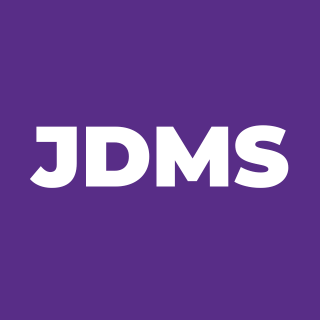
Journal of Dance Medicine & Science
@JDMS_IADMS
Followers
617
Following
3
Media
83
Statuses
128
The official publication of @IADMS. Advancing dance medicine and science knowledge to promote health for dancers, and dance for health.
Joined March 2021
The Journal of Dance Medicine & Science is now part of the SAGE journals. We are optimistic that this change will help advance our journal and provide members with more resources to access the latest dance medicine and science research. https://t.co/hi18fngqk6
1
4
19
This paper provides resourceful recommendations, encouraging researchers to remain imaginative and curious through application of arts-based, person-centered, collaborative mixed methods within their own studies. https://t.co/xCipn4Iq7g
0
5
3
Creative dance classes, delivered within an inclusive preschool environment, are feasible for some preschool-aged children with Developmental Disabilities to participate in and efficacious as a physical training challenge at low activity doses. https://t.co/PM7o4hKT6t
0
1
3
The results of this study highlight the role of dance as a complementary non-pharmacological intervention to improve people with Parkinson's Disease turning performance, leading to a better functional mobility. https://t.co/rqA9DDYXcZ
0
4
3
The results of this study indicate that despite having a lower relative stretching intensity, ballet dancers experienced similar changes as non-dancers after 5 minutes of static stretching. https://t.co/36CBNZINmW
0
2
2
A brief didactic and hands-on workshop improves knowledge and awareness for generalist physicians on evaluation and management of Achilles tendinopathy exacerbation in elite athletes until definitive care is arranged. https://t.co/etCotBdeIo
0
0
2
Pre-professional and professional male dancers hold generally negative beliefs around the low back and low back pain. However, male dancers beliefs around dance-specific movements are often positive and, largely, unrelated to the presence of low back pain. https://t.co/FhEhY9n68o
0
2
5
The findings validated the existence of 4 distinct reconstructed identities associated with time distance from injury. These identities can assist in detecting injured dancers needing help, tailoring counseling methods and tracking rehabilitation. https://t.co/D4O8SZG8SJ
0
2
2
Research papers don’t have to be overwhelming. Here's a simple breakdown.
3
169
744
University dance students wearing the Backalast® jacket, augmented with elastic bands, showed more accurate trunk pelvic joint angle reproduction after sensory diminished trunk movements compared to an elastic control top. https://t.co/tdAjBgP3i8
0
1
1
The run approach produced improved grand jeté distances than other approaches and appears best for float through the air. Plié angles for the assemble’s 2-legged take off are larger than the single-legged take offs from the run, chasse, chaine, and step step approaches.
0
1
7
Low body fat percentage (PBF) in female elite adolescent dancers is associated with menstrual disorders, emphasizing the importance of monitoring PBF in this population. https://t.co/qfn3oJHJU7
0
2
4
Adolescent Pre-Professional Ballet Dancers in Australia require additional support to report, prevent, and manage their dance-related injuries. Health professionals should increase their dance literacy to improve quality of care and enhance rehabilitation. https://t.co/sUJaMTIm7o
0
5
6
Research exploring dance specific fitness tests suggest that the DAFT and the HIDT can be used to determine whether a dancer is fit to perform with the DAFT being the preferred test to monitor both aerobic and anaerobic fitness. https://t.co/4R5hTRnmz5
0
3
5
Dancers’ blood lactate and heart rate responses were similar across time in both active and passive recovery, with HR being higher in AR. Kathak dancers therefore can choose either AR or PR as their recovery mode based on their individual preferences. https://t.co/lUU1RZ0lXg
0
4
3
Studies examining the effect of pointe shoes on dancers are heterogenous in their aims, outcome, measures and methods. Knowledge gaps exist regarding functional/performance outcomes and injury outcomes (e.g. shoe age/usage and shoe treatment factors) https://t.co/l8arhfAV8p
0
2
4
Flexibility athletes successfully regained range of motion, including external rotation/turnout, 1-year after periacetabular osteotomy for the treatment of symptomatic hip dysplasia. Read more here: https://t.co/8uUD7W9RPP
0
2
3
Professional ballet dancers exhibit less posterior inclination during the end phase of pirouettes and finish turns without jumping in comparison to experienced amateur dancers. Read more here: https://t.co/wpwHMKRDiu
0
0
5
Research on strength training perceptions among circus and dance students suggests a shift in perceptions, with a mostly positive perception of strength training, and a desire to receive guidance in this area. Read more here: https://t.co/jl18b1EYFi
0
4
8
Young professional ballet dancers have different gait patterns, but similar dynamic gait stability compared to non-dancers when walking. Ballet dancers take longer and narrower steps but walk faster and with higher cadence. Read more here: https://t.co/VHg81mAnhS
0
3
7
Research on Hungarian female dancers found this population experienced high perceived levels of stress in their everyday lives and suffered from acute musculoskeletal complaints. Read more here: https://t.co/LVPAH2iove
0
2
5

